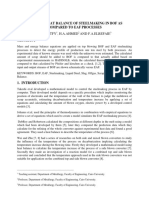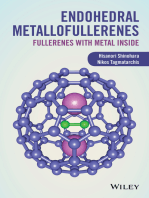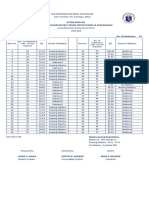0 ratings0% found this document useful (0 votes)
21 viewsGeochemistry & Earth Processes
Geochemistry & Earth Processes
Uploaded by
Youssef OuahziziThis document discusses using major oxides in sediments to analyze source area weathering conditions and paleoclimate. It describes how chemical weathering of feldspar affects major oxide concentrations and how indices like CIA can indicate weathering intensity. Steady-state vs non-steady-state weathering can be identified from major oxide patterns. Ratios of elements like Mg/Al have been used as climofunctions to estimate paleorainfall amounts, while other proxies may allow reconstructing paleotemperatures from major oxide data. The document outlines calculating weathering indices and making ternary plots to visualize major oxide patterns for interpreting past weathering and climate conditions.
Copyright:
© All Rights Reserved
Available Formats
Download as PDF, TXT or read online from Scribd
Geochemistry & Earth Processes
Geochemistry & Earth Processes
Uploaded by
Youssef Ouahzizi0 ratings0% found this document useful (0 votes)
21 views27 pagesThis document discusses using major oxides in sediments to analyze source area weathering conditions and paleoclimate. It describes how chemical weathering of feldspar affects major oxide concentrations and how indices like CIA can indicate weathering intensity. Steady-state vs non-steady-state weathering can be identified from major oxide patterns. Ratios of elements like Mg/Al have been used as climofunctions to estimate paleorainfall amounts, while other proxies may allow reconstructing paleotemperatures from major oxide data. The document outlines calculating weathering indices and making ternary plots to visualize major oxide patterns for interpreting past weathering and climate conditions.
Original Title
Untitled
Copyright
© © All Rights Reserved
Available Formats
PDF, TXT or read online from Scribd
Share this document
Did you find this document useful?
Is this content inappropriate?
This document discusses using major oxides in sediments to analyze source area weathering conditions and paleoclimate. It describes how chemical weathering of feldspar affects major oxide concentrations and how indices like CIA can indicate weathering intensity. Steady-state vs non-steady-state weathering can be identified from major oxide patterns. Ratios of elements like Mg/Al have been used as climofunctions to estimate paleorainfall amounts, while other proxies may allow reconstructing paleotemperatures from major oxide data. The document outlines calculating weathering indices and making ternary plots to visualize major oxide patterns for interpreting past weathering and climate conditions.
Copyright:
© All Rights Reserved
Available Formats
Download as PDF, TXT or read online from Scribd
Download as pdf or txt
0 ratings0% found this document useful (0 votes)
21 views27 pagesGeochemistry & Earth Processes
Geochemistry & Earth Processes
Uploaded by
Youssef OuahziziThis document discusses using major oxides in sediments to analyze source area weathering conditions and paleoclimate. It describes how chemical weathering of feldspar affects major oxide concentrations and how indices like CIA can indicate weathering intensity. Steady-state vs non-steady-state weathering can be identified from major oxide patterns. Ratios of elements like Mg/Al have been used as climofunctions to estimate paleorainfall amounts, while other proxies may allow reconstructing paleotemperatures from major oxide data. The document outlines calculating weathering indices and making ternary plots to visualize major oxide patterns for interpreting past weathering and climate conditions.
Copyright:
© All Rights Reserved
Available Formats
Download as PDF, TXT or read online from Scribd
Download as pdf or txt
You are on page 1of 27
GEOCHEMISTRY & EARTH PROCESSES
= Major Oxides - Source Area Weathering and Paleoclimatic Conditions =
DR. MOHAMED EL MOURABET
AGENDA
1. Major Oxides
2. Normalisation of Major Oxides
3. Major Oxides Patterns
4. Geochemical proxies and Weathering profiles
5. Climofunctions and Paleoclimatic Conditions (Rainfall and Paleotemperature)
6. Major Oxides and Geodynamic settings
Major Oxides Labile Elements &
Chemical Paleoweathering Profiles
Major Oxides - Weathering
Major oxides – Trace Elements
Normalisation to UCC
Major Oxides – carbonates corrections
Laboratory Practical Work
CaO* = CaO – (CaOCarb-Dol + CaOpyrite (10/3))
Vol Co2 dégagé = V2-V1
Vol Carbonates pures Ca2CO3
v1=17 V2 = 91,50
V2-V1 = 74,50
%CO2 = (Vol CO2 Ech/ VolTém )*100
wt%CO2 = %CO2/10
wt% CaOCarb-Dol = wt%CO2*(100,09/44,01)
Conc CaO* = Conc Na2O (Mclennan et al 1993)
Major Oxides - Weathering
SiO2, TiO2, Al2O3, Fe2O3, FeO, MgO, MnO,CaO, Na2O, K2O, P2O5, LOI
The chemistry of weathering typical upper crustal rocks can be approximated by the
weathering of feldspar and volcanic glass, comprising some 75% of the labile material in the
upper crust.
the dominant process during chemical weathering of the upper crust is the alteration of
feldspar and subsequent formation of clay minerals
the major-element geochemistry and mineralogy of siliciclastic sediments are strongly affected
by chemical weathering
various reliable geochemical proxies (i.e. chemical index of alteration (CIA; Nesbitt and Young
1982), chemical index of weathering (CIW; Harnois 1988), plagioclase index of alteration (PIA;
Fedo et al. 1995) may, however, offer a valuable opportunity to assess weathering intensity and
paleoclimate conditions
During weathering processes, high CIA values reflect the removal of labile cations (e.g. Ca2+,
Na+, K+) relative to stable residual constituents. Conversely, low CIA values indicate the near
absence of chemical alteration, reflecting consequently cool and/or arid paleoclimatic
conditions
However, complex geochemical processes involving potassium metasomatism might occur
during chemical weathering beside mechanical breakdown, and continued chemical
alteration during transport, burial, and diagenesis
Major Oxides – Weathering – System A-CN-K
Much of the chemical variation resulting from weathering may be expressed in the system
A12O3 - (CaO* - Na2O) - K20, where CaO* represents the Ca in the silicate fraction only.
Index of chemical alteration (CIA; Nesbitt and Young 1982), in molecular proportions:
CIA = [Al2O3/(Al2O3 + CaO* + Na2O + K20)]*100
CIA values of about 45-55 indicate virtually no weathering (the average upper crust has a
CIA value of about 47), whereas values of 100 indicate intense weathering with complete
removal of the alkali and alkaline earth elements.
Samples can form a cluster in a limited area, indicating steady-state weathering
conditions which imply that physical and chemical processes balance was similar
Samples can plot on a straight line probably deviating from the theoretical trend (IWT),
and departing from a source intersecting the feldspar join toward the A-K join close to the
Illite-Muscovite area. The studied samples may have a higher variability of the CIA index
and hence indicating non-steady state weathering conditions with low to intense
chemical weathering.
CIW= Al2O3/ (Al2O3+CaO*+Na2O) x 100
PIA = ([(Al2O3–K2O)/ (Al2O3+CaO*+Na2O–K2O)] x100)
Steady-state & non Steady-state Weathering
Conditions
Calculation of weathering index values, molar element ratios, and ternary plot locations from major element composition (wt. %)
Enter measured values into blue cells Calculated (automatic) values are in yellow cells
Note: Totals, weathering indices, and ternary plots use total Fe as Fe2O3
wt. % anhydrous wt. % moles of oxide Fe concentrations
SiO2 37,4 50,49 0,8403698 wt. % moles of oxide
TiO2 0,33 0,45 0,0055785 Fe2O3(T) 2,14
Al2O3 11 14,85 0,1456519 FeO(T)
Fe2O3(T) 2,14 2,89 0,0180926 FeO 0 0,0000000
FeO(T) 1,93 2,60 0,0361868 Fe2O3(T) 2,14 0,0134012
Major element oxides
MgO 1,71 2,31 0,0572803 FeO(T) 1,93 0,0268021
MnO 0,05 0,07 0,0009516 Fe moles (element speciation)
CaO 19,2 25,92 0,4622470 ∑Fe 0,0268024
Na2O 0,61 0,82 0,0132875 Fe2+ 0,0000000
K2O 1,33 1,80 0,0190626 Fe3+ 0,0000000
P2O5 0,3 0,41 0,0028534
LOI 23,5
Total (+LOI) 97,57
Total (-LOI) 74,07 100,00
CaO* 0,0098420
A-CN-K plot (CIA)
CIA 77,5 moles sum 0,187844
Chemical weathering indices
PIA 84,6 A 77,5
MgI 71,8 CN 12,3
CALMAG 68,5 K 10,1
MIA[O] 62,2 recast total 100,0
MIA[R] 55,3
A-CNK-FM plot (MIA[R])
LOI 26,0 moles sum 0,263217
A 55,3
CIA-K 86,3 CNK 16,0
MIA[O]-K 67,1 FM 28,6
Molar oxide ternary plots (recast values for plotting)
MIA[R]-K 59,7 recast total 100,0
Al/Ti 52,2 A-L-F plot (MIA[O])
Molar element ratios
moles sum 0,263217
∑Fe/Ti 4,8 A 55,3
Fe2+/Ti 0,0 CNKM('L') 37,8
Fe3+/Ti 0,0 F 6,9
recast total 100,0
∑Fe/Al 0,092
Fe2+/Al 0,000 AF-CNK-M plot (MIA[O])
Fe3+/Al 0,000 moles sum 0,263217
AF 62,2
CNK 16,0
M 21,8
recast total 100,0
A-C-M plot (CALMAG)
moles sum 0,212774
A 68,5
C 4,6
Climofunctions – Source Area Paleoclimatic
conditions
Major oxides – Climofunctions and
Paleoclimatic Conditions
Ratios of elemental compositions in soil provide useful tools for estimating rainfall
and infer palaeotemperature. Thus palaeoprecipitation rate and rainfall within the
source area can be successfully determined from different climofunctions using
alkali and alkaline earth elements (Ca, Mg, Na, K and Al),
Mean annual precipitation 1 (MAP 1) = 14.265(CIA - K) – 37.632 (Maynard 1992)
Mean annual precipitation 2 (MAP 2) = 259:34 ln(B) + 759.05 (Maynard 1992)
where B = molar ratio of bases (CaO, MgO, Na2O, K2O) to Al2O3
Mean annual precipitation 3 (MAP 3) = 130.93 ln(C) + 467.4 (Retallack 2001)
where C = molar ratio of CaO to Al2O3
Mean annual temperature can be estimated from the formula:
Mean annual temperature = -18:51(S) + 17.2989 (Sheldon et al. 2002)
Where S is the molecular ratio of Na2O and K2O to Al2O3
MAP vs CIA-K
Regressive curves
Compositional Maturity – ICV & First Cycle or
Recycled Sediments
ICV – Index of Compositional Variability
The maturity of clastic sediments is calculated by using the Index of
Compositional Variability (ICV; Cox et al. 1995); (Major oxides are in Wt%)
[ICV=(CaO+K2O+Na2O+Fe2O3+MgO+MnO+TiO2)/Al2O3]
Typical rock-forming minerals (i.e. feldspars, amphiboles, and pyroxenes) show
ICV values >0.84, whereas alteration products such as Kaolinite, Illite, and
muscovite show ICV values <0.84 (Cox et al. 1995).
Chemically immature sediments have ICV values>0,84 and are typical of
compositionally first-cycle immature sedimentary rocks are first-cycle deposits
derived from tectonically active settings, where chemical weathering played a
modest role as attested by low to medium CIA and CIA’ values
On the contrary mature sediments have ICV values<0,84 are typical of
tectonically quiescent or cratonic environments where sediment recycling is
active, but may also be produced by intense chemical weathering (high CIA
values) of first-cycle material.
Compositional Maturity – ICV vs CIA
Major Oxides &
Tectonic Settings
Geochemistry and Geodynamic Settings
Modelisations
Geochemistry and Geodynamic Settings
Modelisations
Major Oxides – Tectonic setting
Excel Formated Files
Verma Tectonic Setting Plots
High-Silica clastic sediments Low-Silica clastic sediments
You might also like
- Working at Height PermitDocument2 pagesWorking at Height PermitFadliansyah Arisetree78% (9)
- Cognitive Computing Model Brief - Hospital Admissions and ED VisitsDocument9 pagesCognitive Computing Model Brief - Hospital Admissions and ED Visitswebsite-yokel-0eNo ratings yet
- 2023 Atrial Fibrillation Guideline-at-a-Glance: Societal StatementDocument5 pages2023 Atrial Fibrillation Guideline-at-a-Glance: Societal StatementMiguel Limaylla ZapataNo ratings yet
- Raw Mix Design SoftwareDocument6 pagesRaw Mix Design SoftwareIrfan Ahmed100% (1)
- GCE Chemistry Data Booklet Issue 2Document35 pagesGCE Chemistry Data Booklet Issue 2purityplus89% (9)
- Stress SWOT AnalysisDocument2 pagesStress SWOT AnalysisNeha ChawareNo ratings yet
- File Lampiran SkripsiDocument13 pagesFile Lampiran SkripsiZulqaidahNo ratings yet
- Mass and Heat Balance of Steelmaking in Bof As Compared To Eaf ProcessesDocument15 pagesMass and Heat Balance of Steelmaking in Bof As Compared To Eaf ProcessesAgil Setyawan100% (1)
- Al., 2002 Baxter Et Al., 2005) - The Volcaniclastic Rocks Locally Incorporate Rounded PlagioclaseDocument16 pagesAl., 2002 Baxter Et Al., 2005) - The Volcaniclastic Rocks Locally Incorporate Rounded PlagioclaseericaNo ratings yet
- Thermodynamic Data and E PH DiagramsDocument23 pagesThermodynamic Data and E PH DiagramsManuel CruzNo ratings yet
- Impact of Fuel Ash On Clinker Quality: Tom LowesDocument3 pagesImpact of Fuel Ash On Clinker Quality: Tom LowesJohn GiannakopoulosNo ratings yet
- Structure of Oxalate IonDocument6 pagesStructure of Oxalate Ionnhidpbiochem.hcmiuNo ratings yet
- Sample: 368aDocument4 pagesSample: 368aNazar JabbarNo ratings yet
- Kamaishilite Ca Al Sio (Oh)Document1 pageKamaishilite Ca Al Sio (Oh)ramzchileNo ratings yet
- Hervé Et Al. (2010a)Document22 pagesHervé Et Al. (2010a)Gabriel GonzálezNo ratings yet
- KatoiteDocument1 pageKatoiteRajuNSanaboinaNo ratings yet
- Petrologi Lanjut-2Document22 pagesPetrologi Lanjut-2CHIKAYUSUFNo ratings yet
- Raw Mix Design SoftwareDocument6 pagesRaw Mix Design Software张群利No ratings yet
- Jasinski 1987Document5 pagesJasinski 1987Het DedhiaNo ratings yet
- Mineral CalculationsDocument7 pagesMineral CalculationsDebasish MahantaNo ratings yet
- Cao Mgo Fe O Al O Sio So: Clinker AnalysisDocument2 pagesCao Mgo Fe O Al O Sio So: Clinker AnalysisFlorenceNo ratings yet
- XRD 001 ReportDocument4 pagesXRD 001 Reportmuhammad akbarNo ratings yet
- IAL Chemistry Data Booklet Issue 3Document35 pagesIAL Chemistry Data Booklet Issue 3jeeshan sayed0% (1)
- Match! Phase Analysis Report: Sample: 02-76-9 (05-70)Document3 pagesMatch! Phase Analysis Report: Sample: 02-76-9 (05-70)Iyan Anggriawan RachmanNo ratings yet
- Chemistry Advanced Level Problem Solving (ALPS-9) - SolutionDocument10 pagesChemistry Advanced Level Problem Solving (ALPS-9) - SolutionAnanmay ChauhanNo ratings yet
- PtCoIn SupplimentaryDocument30 pagesPtCoIn SupplimentaryAkundi VsjNo ratings yet
- Clinker Coating ToolDocument1 pageClinker Coating ToolYhaneNo ratings yet
- 1 PDFDocument1 page1 PDFRishabhNo ratings yet
- S Ss SS: B B B B B E E E E EDocument1 pageS Ss SS: B B B B B E E E E ESudhaSharmaNo ratings yet
- Za Buy EliteDocument1 pageZa Buy EliteramzchileNo ratings yet
- Yoshioka It eDocument1 pageYoshioka It eramzchileNo ratings yet
- Schwab Updated FileDocument7 pagesSchwab Updated Fileprayag527No ratings yet
- Spencer Calculation of Heat Capacity Group Contribuiton 1-s2.0-S0040603197004693-MainDocument21 pagesSpencer Calculation of Heat Capacity Group Contribuiton 1-s2.0-S0040603197004693-MainMayela Apaza TtitoNo ratings yet
- Dados Termodinâmicos - FinalDocument157 pagesDados Termodinâmicos - FinalAlmerindo JuniorNo ratings yet
- OREAS 74aDocument23 pagesOREAS 74aSri RatnaNo ratings yet
- lp7 Report2Document5 pageslp7 Report2windaNo ratings yet
- Lp7 ReportDocument5 pagesLp7 ReportwindaNo ratings yet
- 1.1table - Mineral ChemistryDocument3 pages1.1table - Mineral Chemistryjako_kcNo ratings yet
- Journal of Fluorine Chemistry 2020, 237, 10959Document6 pagesJournal of Fluorine Chemistry 2020, 237, 10959RohanNo ratings yet
- Yagiite (Na K) MG (Al MG) (Si Al) ODocument1 pageYagiite (Na K) MG (Al MG) (Si Al) OramzchileNo ratings yet
- Kali Pyro Chlo ReDocument1 pageKali Pyro Chlo ReramzchileNo ratings yet
- Teruggite Ca Mgas B O (Oh) 14H O: Crystal DataDocument1 pageTeruggite Ca Mgas B O (Oh) 14H O: Crystal DataHeza FirdausNo ratings yet
- Tutor 2Document4 pagesTutor 2Nguyễn Minh KhuêNo ratings yet
- Cyanide Compendium Excerpt For Degradation - RODocument22 pagesCyanide Compendium Excerpt For Degradation - ROSeguridad MarvannssNo ratings yet
- Yavapai It eDocument1 pageYavapai It eramzchileNo ratings yet
- Tutorial 7Document10 pagesTutorial 7Noble MathewsNo ratings yet
- Chemistry: Written Examination 2Document3 pagesChemistry: Written Examination 2Mohamed MawasNo ratings yet
- Hyrdogen Storage TechnologiesFrom EverandHyrdogen Storage TechnologiesMehmet SankirNo ratings yet
- Deactivation of Heavy Oil Hydroprocessing Catalysts: Fundamentals and ModelingFrom EverandDeactivation of Heavy Oil Hydroprocessing Catalysts: Fundamentals and ModelingNo ratings yet
- Endohedral Metallofullerenes: Fullerenes with Metal InsideFrom EverandEndohedral Metallofullerenes: Fullerenes with Metal InsideNo ratings yet
- The Chemistry of Membranes Used in Fuel Cells: Degradation and StabilizationFrom EverandThe Chemistry of Membranes Used in Fuel Cells: Degradation and StabilizationShulamith SchlickNo ratings yet
- Novel Carbon Materials and Composites: Synthesis, Properties and ApplicationsFrom EverandNovel Carbon Materials and Composites: Synthesis, Properties and ApplicationsXin JiangNo ratings yet
- Molecular Modeling of Corrosion Processes: Scientific Development and Engineering ApplicationsFrom EverandMolecular Modeling of Corrosion Processes: Scientific Development and Engineering ApplicationsNo ratings yet
- Heterogeneous Catalysis at Nanoscale for Energy ApplicationsFrom EverandHeterogeneous Catalysis at Nanoscale for Energy ApplicationsNo ratings yet
- Vibrational Spectra of Organometallics: Theoretical and Experimental DataFrom EverandVibrational Spectra of Organometallics: Theoretical and Experimental DataNo ratings yet
- On Solar Hydrogen and NanotechnologyFrom EverandOn Solar Hydrogen and NanotechnologyLionel VayssieresNo ratings yet
- Unusual Structures and Physical Properties in Organometallic ChemistryFrom EverandUnusual Structures and Physical Properties in Organometallic ChemistryNo ratings yet
- Advanced Battery MaterialsFrom EverandAdvanced Battery MaterialsChunwen SunNo ratings yet
- 608 Plaintiff's Motion To Enforce Order Graanting Writ, 11.05.2020Document7 pages608 Plaintiff's Motion To Enforce Order Graanting Writ, 11.05.2020lschneider68No ratings yet
- FM Global Report SprinklersDocument109 pagesFM Global Report SprinklersManuel Otero AlzaNo ratings yet
- Ultrasonic Testing and Acceptance Standard For Fabricated Armature ShaftDocument4 pagesUltrasonic Testing and Acceptance Standard For Fabricated Armature ShaftveeramalaiNo ratings yet
- Item Analysis - Third GradingDocument5 pagesItem Analysis - Third GradingChristine diane VasquezNo ratings yet
- E-WASTE Seminar ReportDocument28 pagesE-WASTE Seminar Reportpushpzala8650% (4)
- The Cost of Capital Lecture (Revised)Document50 pagesThe Cost of Capital Lecture (Revised)Ranin, Manilac Melissa S50% (4)
- Diagnostic Series SA - Gig, Ancient Innovations & Adaptations (W. McGrath) 2016Document77 pagesDiagnostic Series SA - Gig, Ancient Innovations & Adaptations (W. McGrath) 2016joseco4noNo ratings yet
- COA of Hydrolysis AA80% Plant Origin From KatyDocument2 pagesCOA of Hydrolysis AA80% Plant Origin From Katyfertilizer exporterNo ratings yet
- Troy-Bilt Tiller 769-00874aDocument72 pagesTroy-Bilt Tiller 769-00874aClayton CromleyNo ratings yet
- Project Certificates Hospital Revised2019Document3 pagesProject Certificates Hospital Revised2019S V ENTERPRISESNo ratings yet
- F 2012081Document2 pagesF 2012081Ahmed SalamaNo ratings yet
- Naplan 2013 Final Test Reading Year 9Document16 pagesNaplan 2013 Final Test Reading Year 9Wania AsifNo ratings yet
- Transformer OilDocument19 pagesTransformer Oilinetbrosingcentre100% (1)
- (샘플 버전) 2020 9월 고2 모의고사-40제 (전지문수록)Document20 pages(샘플 버전) 2020 9월 고2 모의고사-40제 (전지문수록)secure17miNo ratings yet
- Requirements in Renewing Business PermitDocument1 pageRequirements in Renewing Business PermitCharina Marie CaduaNo ratings yet
- Onwuagamba 2018 The Role of Filth Flies' in The Spread of Antimicrobial ResistanceDocument10 pagesOnwuagamba 2018 The Role of Filth Flies' in The Spread of Antimicrobial ResistanceClaudia TorresNo ratings yet
- Evidence For EvolutionDocument12 pagesEvidence For Evolutionapi-259727482100% (2)
- Spec Pro GuardianshipDocument8 pagesSpec Pro GuardianshipSherlyn Paran Paquit-Selda100% (1)
- La5 Perpetuation of LifeDocument13 pagesLa5 Perpetuation of LifeRenz Bilbao SabonsolinNo ratings yet
- Chap 6 Students Who Are GiftedDocument10 pagesChap 6 Students Who Are GiftedAfif KimNo ratings yet
- Ag Ss Kx6 Fdc400kxe6Document3 pagesAg Ss Kx6 Fdc400kxe6Shafik AtwiNo ratings yet
- Chemistry JokesDocument5 pagesChemistry JokesDaisy LuNo ratings yet
- Hit The BrakesDocument9 pagesHit The Brakesakivara100% (1)
- Statistics Unit 9 NotesDocument10 pagesStatistics Unit 9 NotesgopscharanNo ratings yet
- Briggs and StrattonDocument28 pagesBriggs and StrattonJay SanghrajkaNo ratings yet
- Contraceptive Comparison ChartDocument1 pageContraceptive Comparison ChartdryasirsaeedNo ratings yet

























































































